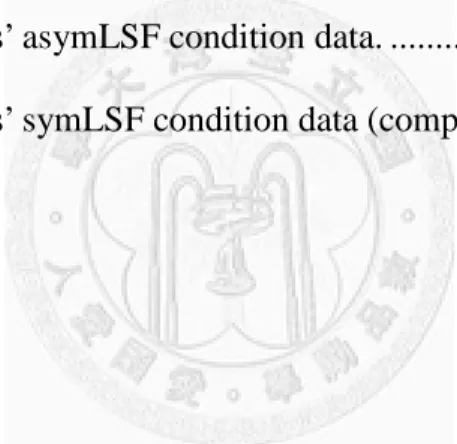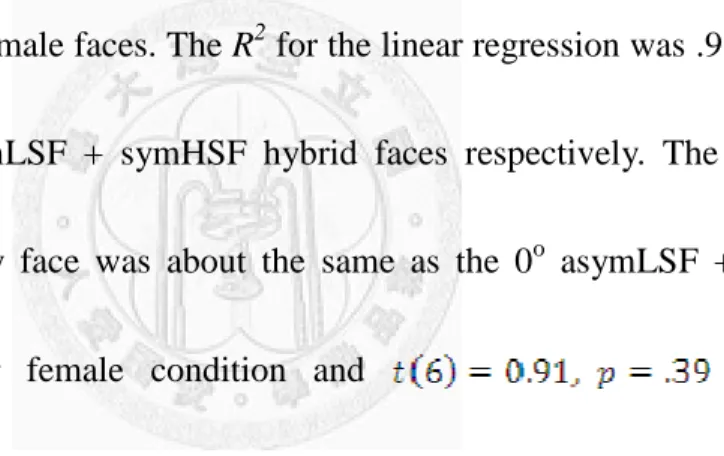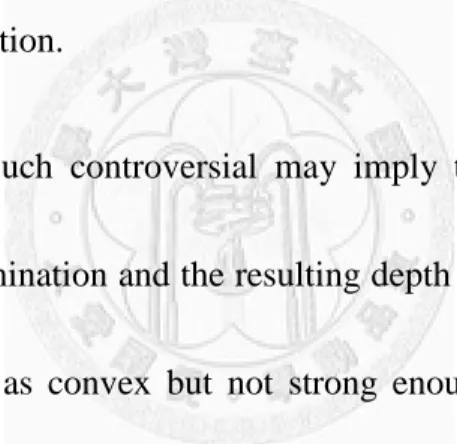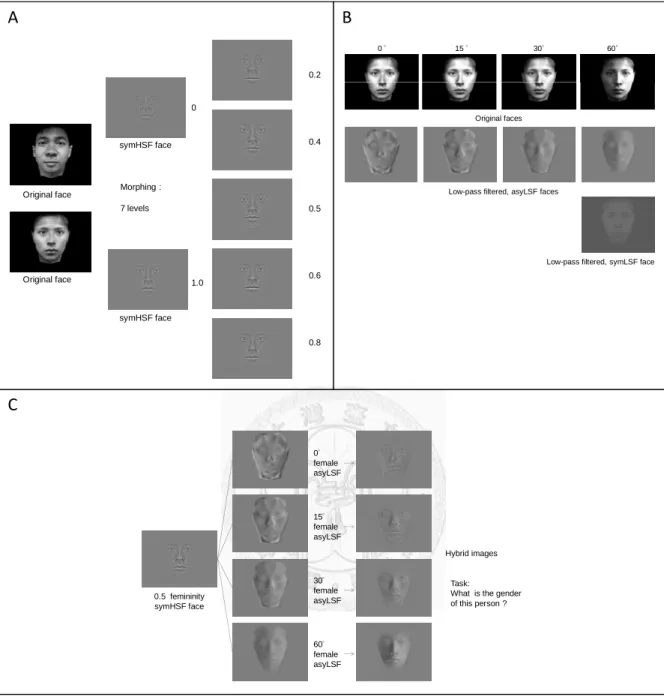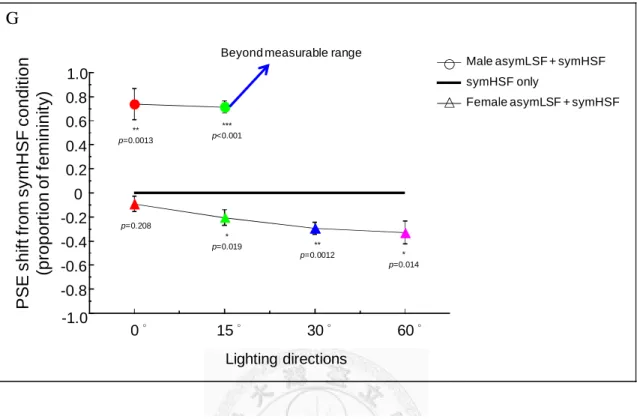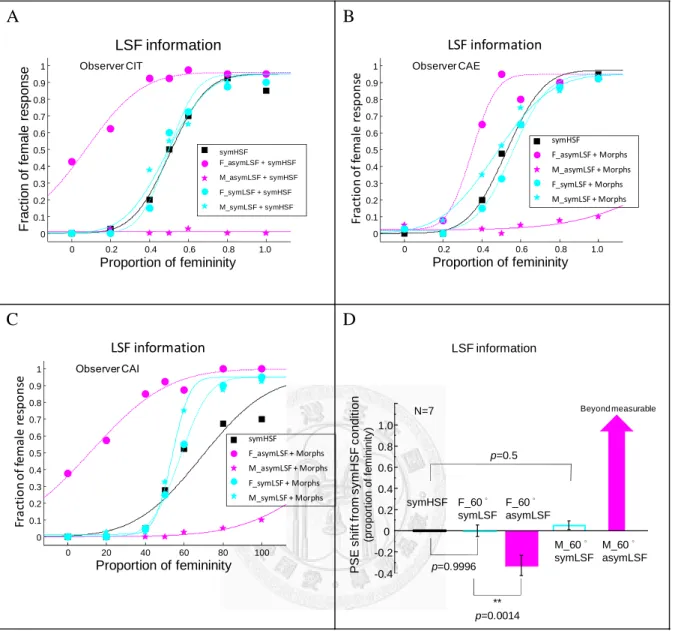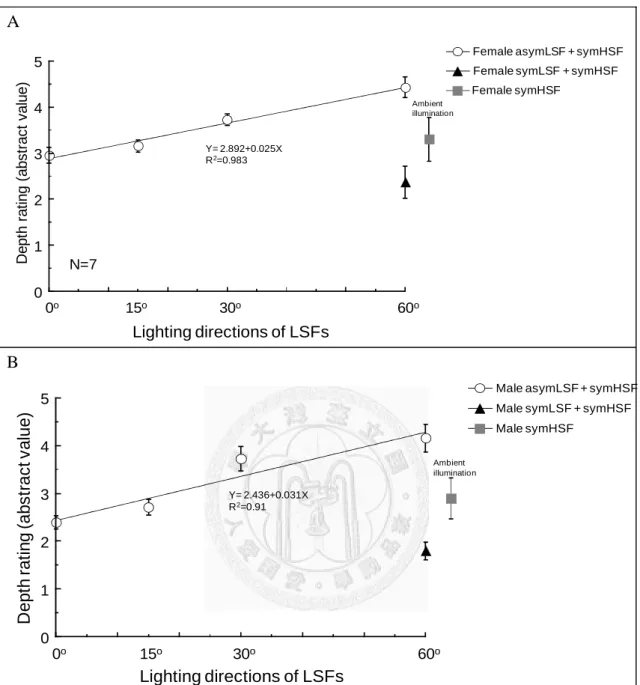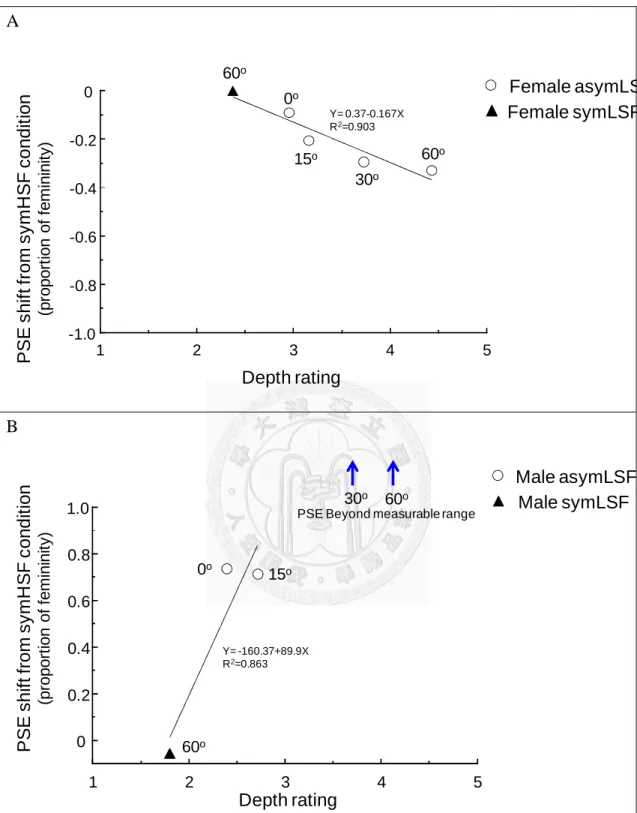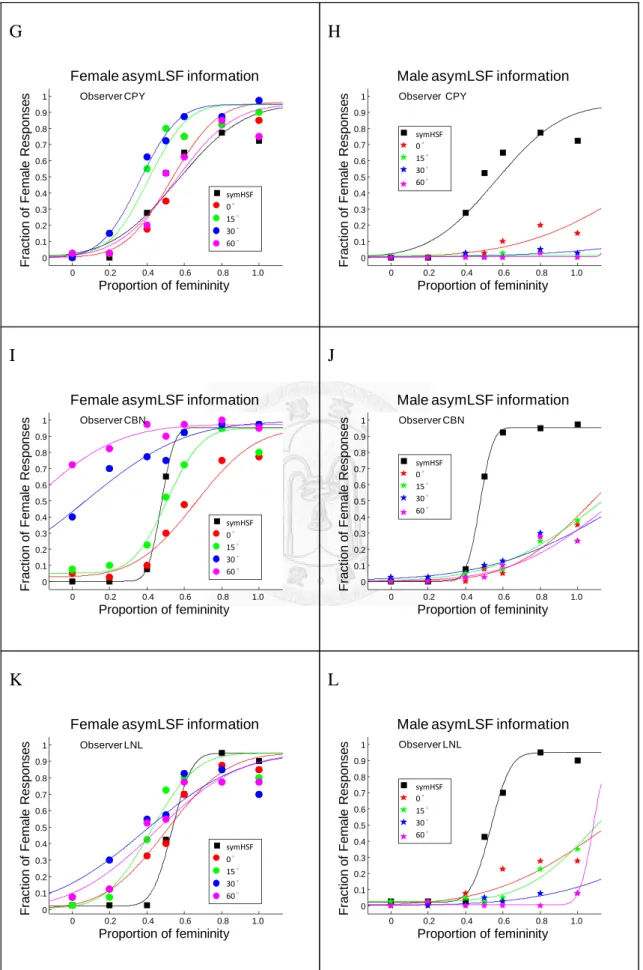國立臺灣大學理學院心理學研究所 碩士論文
Graduate Institute of Psychology College of Science
National Taiwan University Master Thesis
非對稱低空間頻率訊息有助於臉孔區辨
Asymmetric Low Spatial Frequency Improves Face Discrimination
陳巾眉 Chin-Mei Chen
指導教授:陳建中 博士
Advisor: Chien-Chung Chen, Ph.D.
中華民國 98 年 6 月
June, 2009
i
誌謝
誌謝 誌謝
誌謝
ii
摘要 摘要 摘要 摘要
本實驗的目的在於理解人類視覺系統如何從陰影的訊息中建構臉部的立體訊 息。我們利用電腦軟體改變投射在 3D 立體臉部模型的光影變化,然後記錄觀察者 對於臉部辨識作業如何隨著照明方向改變而有所不同。我們使用對稱性算則分離 臉部影像的照明與臉部的表面特質。我們一共區分了對稱與不對稱的低空間頻率 和高空間頻率的四種成分。實驗刺激是這些不同成份的組成。結果顯示非對稱低 空間頻率成分,亦即陰影訊息會顯著改變臉部辨識。然而,對稱的低空間頻率成 分卻對臉部辨識沒有影響。此外;非對稱低空間頻率也會改變臉部影像的深度知 覺。總結以上結果 可以確定的是非對稱低空間頻率訊息決定了臉部的特性以及深 度知覺。而且這個效果隨著照明光源角度的改變而有所不同。所以,我們的結果 支持視覺系統中以立體維度來處理臉部辨識的訊息。
關鍵詞:陰影造型法、照度、對稱性、臉孔知覺、三度空間物體。
iii
Asymmetric Low Spatial Frequency Information Improves Face Discrimination
Chin-Mei Chen Abstract
To study how the visual system compute 3D shape of faces from shading information, we manipulated the illumination conditions on 3D scanned face models and observed how the face discrimination changes with lighting directions . We used a symmetry algorithm to dissociate surface albedo and illumination component of face images by separating symmetric and asymmetric components of both low and high spatial frequency information of face images. Stimuli were hybrid faces with different combination of symmetric and spatial content. Results show that asymmetric low spatial frequency (shading) information had significant influence on face discrimination, while the symmetric ones have little, if any, effect on face discrimination. The asymmetric low spatial frequency also changed the perceived depth of hybrid faces. Together, these results suggest that (1) the asymmetric low spatial frequency information dramatically affects both perceived face identity and perceived depth; and (2) this effect increased as the lighting direction shifts to the side. Thus, our results provide an evidence for
3D-based face processing.
Key words: Shape from shading, illumination, symmetry, face perception, 3D object.
iv
CONTENTS
Chapter 1 Introduction ... 1
Chapter 2 Method ... 7
2.1 Apparatus ... 7
2.2 Stimuli ... 7
2.3 Procedure ... 11
2.3.1 Face discrimination ... 11
2.3.2 Depth judgment ... 12
2.4 Data analysis ... 12
2.5 Participants ... 13
Chapter 3 Results ... 14
3.1 asymLSF information changed perceived facial information of hybrid faces.14 3.2 symLSF information did not change perceived facial information of hybrid images. ... 16
3.3 Depth judgment ... 17
Chapter 4 Discussion... 18
4.1 Illumination effects in face recognition ... 18
4.2 Spatial frequency effect ... 20
Chapter 5 Conclusions ... 22
References ... 23
List of Figures ... 28
Supplementary data ... 35
v
LIST OF FIGURES
Figure 1 The symmetric algorithm helps to dissociate the contribution of the surface albedo from illumination component in image. ... 28 Figure 2 Examples of stimuli... 29 Figure 3 The effect of asymLSF on face discrimination. ... 31 Figure 4 Comparisons of the effect of asymLSF and symLSF on face discrimination. .. 32 Figure 5 Results of depth judgment. ... 33 Figure 6 Face discrimination performance is highly correlated with perceived depth. .. 34 Figure 7 All seven observers’ asymLSF condition data. ... 36 Figure 8 All seven observers’ symLSF condition data (compared with asymLSF data). 36
1
Chapter 1 Introduction
We perceive a 3D object when light reflected from its surface arrive our retinal.
The retinal image, however, is two-dimensional. Hence, the question is how the visual
system reconstructs a 3D representation of an object from 2D retinal images. It is well
known that a human observer can utilize depth cues available in an image to facilitate
this reconstruction. One of the useful cues is shading, or gradual variation of the
luminance on a surface (Horn, 1970). The luminance of a point on a surface depends on
not only the intensity and the incident angle of the light reaching the surface but also the
slant of the surface at that point, which determines the proportion of the light reflected
from the surface reaches the eyes of an observer. Hence, under the same illumination,
the shading provides information of the slant and in turn determined the relative depth
of each point on the surface (Horn, 1986; Horn & Brooks, 1989). Ramachandran (1988a,
1988b) further showed that the human visual system uses two assumptions in extraction
of shape from shading information: One is that there is a single light source illuminating
the whole scene, and the other is that the light is shining from above. With these two
constraints, the visual system is able to solve shape from shading problem as the
top-bottom luminance gradient from bright to dark suggests a convex surface while the
2
gradient from dark to bright, a concave surface. Such effect is best demonstrated in the
crater illusion in which inverting an image can alter the perception of surface from
convex to concave and vice versa (Gibson, 1950).
The Ramachandranian shape from shading has its limit. As shown in the hollow
face illusion (Gregory, 1970), a hollow face is always perceived as a convex regardless
whether the lighting is from above or from bottom. One interpretation for this hollow
face illusion is that the faces are familiar objects with known shape, and thus does not
require shading information to resolve its 3D shape. Hence, the face perception should
be insensitive to shading. This interpretation, however, contradicts with a number of
studies showing that face recognition is impaired when the luminance distribution of a
face image is inverted as in photographic negative (Gilad, Meng, & Sinha, 2009;
Johnston, Hill, & Carman, 1992; Kemp, Pike, White, & Musselman, 1996; Liu &
Chaudhuri, 1997). In addition it is showed that it is more difficult to recognize
bottom-lit faces than top-lit faces (Hill & Bruce, 1996; Johnston et al., 1992; Liu, Collin,
Burton, & Chaudhuri, 1999; Liu, Collin, Rainville, & Chaudhuri, 2000). That is, a
change of illumination condition has little effect on shape from shading on a face but
does have an effect on face recognition. However, to best of our knowledge, there is no
reliable measurement on whether observers perceive the same depth on a hollow face or
3
a bottom-lit face as they do on a normal top-lit face. Perhaps only part of information on
those unnaturally lit face can be recovered by the visual system, and the information is
enough to perceive a hollow face as convex but not enough for an observer to recognize
a bottom-lit face as good as a top-lit one.
We thus investigated the effect of shading on face perception by observing how
face discrimination ability changes with lighting directions. To avoid nuisance
“naturalness” factor that may result from Ramachandranian lighting-from-top constraint,
we shifted the position of light source laterally from the front to the side of a face.
Hence, all light source positions are ecologically equally plausible. The illumination and
face information can be separated by an algorithm based on the assumptions that the
face is symmetric (Grammer & Thornhill, 1994; Rhodes, 1988; Rhodes, Geddes, Jeffery,
Dziurawiec, & Clark, 2002; Rhodes, Peters, Lee, Morrone, & Burr, 2005) and is
illuminated by a single light source. Facial characteristics may be partitioned into two
types. One is the information from the inherent coloration and reflectance properties of
the facial surface, known as the surface albedo. And the other is information from the
illumination of the 3D face shape, termed the illumination component. Notice that the
luminance component cannot have a luminance less than zero, we can recast them in
terms of their contrast variation around the mean (scaled as 1) over the domain
4
where is the contrast of the inherent coloration of the face, or albedo. And
is the illumination component. Since both and in eq. 1 are constrained to
be less than one, their product in the interaction term must be much less than 1 and can
therefore be considered negligible in most situations. Thus,
Each term may be specified in terms of its symmetric (S) and asymmetric (A)
components:
where and for the illumination
component. And for the albedo component that is assumed to be
in symmetric view, and therefore has no asymmetric component .
All that is needed for complete segregation of the surface albedo from the
illumination component is to distinguish the residual symmetric illumination component
LS from the entire albedo component CS. We hypothesize that a) CS contains
predominantly high-frequency energy whereas LS contains predominantly
5
low-frequency energy. And b) the remaining frequency bands in each case are of little
relevance to face reconstruction. Hence, we can separate the two symmetric components
by a spatial frequency filter. Figure 1 demonstrates our method. Panel A is the
asymmetric low spatial frequency component that represents the asymmetric
illumination information, , of the original face image ( , panel C) while
Panel B is the symmetric high spatial frequency that represents the albedo component
( ). The hybrid face in Panel E is the sum of the LA and CS and is almost
perceptually identical to the original face. That is, the combination of the asymmetric
high frequency and the symmetric low spatial frequency ( ) components (Panel
D) plays little role in face perception. Hence, subtracting them from the original face
image affects little of our face perception.
Therefore, in the current study, we investigated how the change of the asymmetric
low spatial frequency by illumination conditions affects face discrimination and depth
judgment on hybrid faces. The hybrid picture paradigm (Schyns & Oliva, 1997, 1999)
was designed to study the relative contribution of specific spatial frequencies. In our
case, the hybrid face would be a combination of CS and LA or CS and LS. If the
illumination condition can affect the retrieval of 3D shape information from a face, we
should expect the change of illumination condition can affect both face discrimination
6
and depth judgment on the hybrid faces. In addition, such illumination effect should
exert their influence through the asymmetric low spatial frequency component of the
face images and not the symmetric ones.
7
Chapter 2 Method
2.1 Apparatus
The stimuli were presented on a ViewSonic VA902 17″ LCD monitor controlled by
a HP D325MT computer with an ATI Radeon 9800PRO graphics card. The spatial
resolution was 1280(H) × 1024(V). The viewing distance was 127.5cm. At this
distance, a pixel subtended about 0.01° (H) × 0.01°(V). The temporal refresh rate of
the monitor was 60Hz (non-interlaced). The gamma function of the monitor was
calibrated with a LightMouse photometer (Tyler & McBride, 1997), and this
information was used to compute linear 8-bit color look–up table. The accuracy of the
look-up tables was verified by an international Light RPS-380 spectroradiometer. The
experimental control software was written in MATLAB (Mathworks Inc., 1993) with
the Psychophysics Toolbox (Brainard, 1997; Pelli, 1997). The display had mean
luminance at 15cd/m2 and chromaticity at (0.33, 0.33) in CIE 1931-xycoordinates.
2.2 Stimuli
The face images were constructed from 3D laser-scanned faces developed by Lin
and his collegues (Lin & Ouhyoung, 2005; Lin, Yeh, & Ouhyoung, 2002). The 3D face
8
models of one female face and one male face with a neutral expression were used. The
front view face images were rendered from the textured 3D models using 3ds Max 2009
(Autodesk, Inc., 2009) . The Blinn–Phong shading model was employed to construct
illumination conditions. We first place four diffused light sources around the model to
produce an even ambient light to keep the shadowed regions from entirely dark. The
point light source was placed at 0°, 15°, 30°, and 60° relative to the tip of the nose and
on the horizontal meridian of faces. That is, the lighting direction of 0o means the light
source is right in front of the face. The relative intensities between the point light source
and the ambient light were 1.5 and 0.2 respectively. In addition, the 3D face models
under ambient illumination were used for constructing symmetric high spatial frequency
only stimuli. All images were grayscale images with 256 gray levels.
As shown in eq. 3a and 3b, face images could be decomposed into three parts:
asymmetric and symmetric illumination components, and symmetric albedo. The
decomposition was achieved by the following steps. First, the face images were Fourier
transformed to the frequency domain. The real and imaginary parts of the transformed
images were taken as symmetric and asymmetric components respectively. Both
symmetric and asymmetric components were multiplied by a Gaussian low pass
and a high pass function, where the cut-off frequency was
9
12 cycles per face width, to extract the low and high spatial frequency information
respectively. With an inverse Fourier transform, we separated the four components of a
face images: Symmetric low spatial frequency (symLSF, corresponding to LS in eq.3a),
symmetric high spatial frequency (symHSF, corresponding to CS in eq. 3b), asymmetric
low spatial frequency (asymLSF, corresponding to LA in eq. 3a), and asymmetric high
spatial frequency (asymHSF). The asymHSF information should have little influence on
3D face perception. Therefore, this part was not used in our experiments. The symHSF
images, looks very flat, convey detailed edge information of facial features and in turn
the precise shape of the eyes, nose, mouth eyelashes, etc. In contrast, the LSF face
images represent the coarse-scale facial configure and illumination information. All
components of all images were normalized to have equal RMS contrast before further
processing.
The hybrid face stimuli we used were a combination of a symHSF only image,
constructed from face images created under ambient illumination condition, and a
symLSF or an asymLSF component of face images created under point lighting
conditions. We used FantaMorph 4.0 (Abrosoft, 2009) to generate morphed images
between the male and female symHSF faces. There were seven morphed symHSF
images with different proportion of femininity between 0 (male) to 1 (female) (0, 0.2,
10
0.4, 0.5, 0.6, 0.8, and 1.0). Figure 2A shows examples of morphed symHSF images.
The asymLSF components were created from faces rendered in four illumination
conditions (0°, 15°, 30°, 60°). The rendered faces and their asymLSF components
under four illumination conditions are illustrated in Figure 2B. To ensure that symLSF
component, which is invariant to asymmetric illumination, has little effect on face
discrimination, we also used the symLSF component of the face under the 60°
illumination as a control.
Finally, the hybrid faces (Figure 2C) contained the symHSF component at a certain
morphing level and asymLSF at one illumination condition or the symLSF component.
The LSF components were from either male or female faces. Totally, there were 56 (4
illumination conditions × 2 genders × 7 morphing level) asymLSF and symHSF
hybrid face images used in the experiment. In addition, for controls, we also used 14
symLSF and symHSF hybrid images (2 genders × 7 morphing level) and 7 symHSF
alone images at different morphing levels. Hence, there were 77 face images used in this
study. The constructed hybrid images were then windowed with a Gaussian filter to
remove irrelevant external cues such as hair, ears, and contour of faces.
11
2.3 Procedure
2.3.1 Face discrimination
We used the method of constant stimuli to measure the proportion of the female
judgment for each test images. In each trial, the observers were presented with one of
the 77 face images for duration of 500 ms. After the presentation; the observers were
shown a blank screen of mean luminance. The observers were asked to make response
at this time. The next trial began one second after the observer made a response. The
task of the observers was to press keys to determine where the presented image was a
male or a female face. The order of presentation of the images was randomized.
Observers were not given feedback about their performance.
A psychometric function consisted of the proportion of the female judgment on
images of the same illumination condition from the face of the same gender at different
morphing levels. There were 40 trials per face image. Hence, with seven morphing
levels, there were 280 trials for a psychometric function. Given 8 asymLSF, 2 symLSF
and one symHSF only conditions, there were totally 11 psychometric functions.
12
2.3.2 Depth judgment
In this experiment, the observers were to judge the relative depth of the face
images. In each trial, observers were presented with one of the face images together
with a reference sphere for 1s. The face and the sphere were presented side by side on
the screen with 3' gap between them. The location (left of right of the fixation) of the
face or the sphere was randomly determined. The observer was to press one of the keys
to rate the relative depth of the faces using a 5-ponit Likert scale, (1–flat, 5–steep).
The observers were asked to use the reference sphere as an anchor of depth 3.
The face images used in depth judgment were images of 0 or 1.0 morphing levels
of those used in face discrimination experiment. The reference sphere were created with
3ds Max 2009 (Autodesk, Inc., 2009). The diameter of the sphere was the same as the
width of the face images and had the 0o lighting direction.
2.4 Data analysis
For each LSF condition, the fraction of female responses was then plotted against
the morphing level of the symHSF component. The psychometric function was fitted
with an accumulated Gaussian function
13
where determines the mean, and in turn the point of subjective equality (PSE), and
determines the slope of psychometric function, and ( ) and ( ) defines the lower and
upper bound of the psychometric function respectively. The differences between PSEs
for different conditions were tested with a two-tailed paired t test.
2.5 Participants
Seven observers with normal or corrected-to-normal vision participated in this
study. All of them were naïve to the purpose of this study and were not familiar with the
people whose faces were used as stimuli. Informed consent was obtained from each
observer before the experiment. The observers were fiscally compensated for their time.
14
Chapter 3 Results
3.1 asymLSF information changed perceived facial information of hybrid faces.
Panel (A)-(F) of Figure 3 show that the fraction of female judgment as a function
of symHSF morphing level for hybrid faces with asymLSF from different lighting
directions in three representative observers. The left column shows the psychometric
functions measured with female asymLSF components, while the right, male asymLSF
components. The psychometric function for symHSF only condition (black squares
and curves) are plotted in the panels for the corresponding observers as a comparison.
The red, green, blue, magenta psychometric curves and symbols denote the
psychometric function for hybrid faces with asymLSF from 0o, 15o, 30o, and 60o
lighting directions respectively.
Adding the asymLSF component from a female face to the symHSF shifted the
psychometric curves to the left. The amount of change in general increased with the
lighting directions. The observers saw a female face even at very low level of femininity.
On the contrary, adding the asymLSF component from a male face shifted the
psychometric functions dramatically to the right. This rightward shift was especially
15
pronounced with the 30° and 60° illumination conditions in which the observers
always saw a male face regardless the female morphing level. Indeed, the male
asymmetric low spatial frequency information had a stronger effect than the female one.
Two studies (Bruce, Healey, Burton, Doyle, Coombes, & Linney 1991; Bruce, et al.,
1993) also showed the similar male advantage effect in face recognition and
discrimination tasks.
To quantify the effect of asymLSF on face discrimination and summarize the
results from all seven observers, we determined PSE (the proportion of femininity of
hybrid faces corresponding to 50% female responses) for each psychometric function of
each observer. Figure 3G shows the mean PSE relative to the symHSF only condition. A
positive value means a rightward shift of the psychometric curve, or more male
responses, relative to symHSF only condition. While a negative value, a leftward shift
or more female responses. The p-value shown in the Figure 3G was a two-tailed paired t
test of comparing PSE of each illumination conditions with the symHSF only condition.
The error bars show 1 standard error (SE) across observers. All asymLSF effects were
significant except female asymLSF from 0o lighting direction. The male asymLSF from
the 30o and 60o conditions were so effective that their PSEs were beyond the measurable
range.
16
3.2 symLSF information did not change perceived facial information of hybrid images.
We also investigated whether the symmetric component of LSF influences face
discrimination as asymLSF. Panel (A)-(C) of Figure 4 show the results of three
representative observers in judging the gender of hybrid faces consisted of symLSF and
symHSF (cyan symbols and curves). The psychometric functions of asymLSF
conditions of the same 60o illumination condition (magenta symbols and curves) and the
symHSF only condition (black symbols and curves) were replotted here as a
comparison. The star symbols denote the male and circles female LSF components.
The symLSF, be contrast with, produced little, if any, effect on the face discrimination
than the asymLSF component. Figure 4D shows a summary of the PSEs from the seven
observers. Relative to the symHSF only condition, the addition of symLSF information
produced no significant effect for female condition
and for male condition). On the other hand, the difference between
asymLSF and symLSF condition was significant for
female condition, and the difference between male conditions was obviously beyond
measurable range).
17
3.3 Depth judgment
Figure 5 shows the depth rating for asymLSF + symHSF (open circles) faces from
four illumination conditions. The depth rating for symLSF + symHSF (closed triangles)
and symHSF only (closed squares) faces is plotted for a comparison. The symHSF
components were from either 1.0 (female, Panel A) or 0.0 (male, Panel B). The
perceived depth for the asymLSF + symHSF faces increased with the direction of
lighting. This increment can be described by a linear regression line with slope 0.025 for
female faces and 0.031 for male faces. The R2 for the linear regression was .983 and .91
for female and male asymLSF + symHSF hybrid faces respectively. The perceived
depth of the symHSF only face was about the same as the 0o asymLSF + symHSF
for female condition and for male
condition) This result is consistent with the PSE shift with different illumination
conditions. That is, as the illumination direction shift to the side, the asymLSF has a
greater effect not only on face perception, but also on perceived depth.
18
Chapter 4 Discussion
Our results showed that asymLSF information did have a profound effect on face
perception as it greatly changed the perceived gender of the hybrid faces in our
observers. That is, the asymLSF component from a female face make the observers
more likely to perceive the hybrid face as a female regardless the source of other
components. While the asymLSF component from a male face had an opposite effect.
But the symLSF component had no such effect. In addition, the effect of the asymLSF
component increased with the lighting directions. The asymLSF component also
affected the perceived depth of hybrid faces. Again, this effect was more pronounced as
the lighting direction shift sideward.
4.1 Illumination effects in face recognition
The local interaction between surface orientation and source of illumination brings
about shading gradients on objects. Consequently, shading pattern would be affected by
changes in illumination conditions. Since shading provides informative implication
regarding 3D shape (Horn, 1970), a different lighting direction could result in changes
in face representation via shading information, as our results suggest. There were
19
studies showing that lighting direction is important for face recognition. In addition to
aforementioned studies investigating the differential effect of top-lit and bottom-lit faces
(Hill & Bruce, 1996; Johnston et al., 1992; Liu et al., 1999; Liu et al., 2000), Braje,
Kersten, Tarr, and Troje (1998) showed left or right illumination variation impaired face
recognition memory. These studies suggested that the lighting directions and
illumination information play an important role in face perception. On the other hand,
the hollow face illusion (Gregory, 1970) shows that 3D perception on a face is not
sensitive to shading information.
As discussed above, such controversial may imply that the visual system may
discount the change of illumination and the resulting depth percept to an extent that the
face can still be perceived as convex but not strong enough to recover all the depth
information. Our result is consistent with the explanation. We showed that the
manipulation of lighting direction changes the shading information on faces, and in turn
changes both the depth perception of faces and performance of face discrimination.
Figure 6 shows that the face discrimination performance is highly correlated with
perceived depth (for female condition, Pearson correlation coefficient, , and
for male condition ). Thus, if the illumination condition did not provide proper
shading information to recover enough depth information, it is difficult for an observer
20
to perceive the identity of the faces.
4.2 Spatial frequency effect
There is considerable evidence indicating the importance of coarse-scale facial
information in face recognition. The pioneering work ‘Lincoln illusion’ demonstrated by
Harmon and Julesz (1973) showed that applying a low-pass filter to remove the high
frequency noise introduced by the sampling and quantizing improved recognition of a
pixelized portrait. Moreover, they suggested that the low spatial frequency is more
critical for face recognition than high spatial frequency. Subsequent studies found the
critical spatial frequency range for face recognition (For a review, see Ruiz-Soler &
Beltran, 2006). Harmon and Julesz (1973) suggested that a spatial frequency as low as
2.5 cycles per face width was sufficient for face identification. Several studies showed
that face recognition is optimal at medium spatial frequencies (between 8 to 16 cycles
per face width) (Costen, Parker, & Craw, 1996; Gold, Bennett, & Sekuler, 1999;
Näsänen, 1999; Parker & Costen, 1999). The cut-off frequency of our low-pass filter
fell in this range. These results indicated that removing of low to medium spatial
frequencies had the most detrimental effect on face recognition than high spatial
frequencies.
21
Unlike aforementioned reports, we did not simply investigate the influence of
specific range of spatial frequencies on face perception. The novelty of this study,
specifically, is to identify that the asymmetric low spatial frequency is more critical in
face perception than the symmetric ones. Since the natural shading is most often to be
asymmetric, due to shape from shading, the more critical facial information should
reside in asymmetric than symmetric components. This notion is confirmed with our
result that (1) the asymmetric low spatial frequency information dramatically affects
both perceived face identity and perceived depth; and (2) this effect increased as the
lighting direction shift to the side.
22
Chapter 5 Conclusions
In this study, with hybrid image paradigm and face images constructed from
different illumination conditions, we demonstrated the role of asymmetric low spatial
frequency information in face discrimination. The asymmetric low spatial frequency
information has a strong influence on face perception as illustrated by its ability to
change the perceived gender of the hybrid faces. In addition, such effect increased as the
lighting direction shifts sideward. In contrast, the symmetric low spatial frequency
information had little, if any, effect on face discrimination. In addition, the asymmetric
low spatial frequency information also affected the perceived depth of a face. Again,
this effect was more pronounced as the lighting direction shifts sideward. Hence, these
results are consistent with the notion that the sideward shift of lighting directions
provides more shading information that increases the perceived depth of
shape-from-shading and in turn improves the facial discriminability in the observers.
23
References
Abrosoft. (2009). FantaMorph 4.0. Beijing: Abrosoft, Inc.
Autodesk, Inc. (2009). 3ds Max 2009. San Rafael, CA: Autodesk, Inc.
Brainard, D. H. (1997). The psychophysics toolbox. Spatial vision, 10(4), 433-436.
Braje, W. L., Kersten, D., Tarr, M. J., & Troje, N. F. (1998). Illumination effects in face
recognition. Psychobiology, 26(4), 371-380.
Bruce, V., Healey, P., Burton, A. M., Doley, T., Coombes, A., & Linney, A. (1991).
Recognising facial surfaces. Perception, 20(6), 755-769.
Bruce, V., Burton, A. M., Hanna, E., Healey, P., Mason, O., Coombes, A., Fright, R., &
Linney, A. (1993). Sex discrimination: How do we tell the difference between
male and female faces? Perception, 22(2), 131 – 152.
Costen, N. P., Parker, D. M., & Craw, I. (1996). Effects of high-pass and low-pass
spatial filtering on face identification. Perception & Psychophysics, 58(4),
602-612.
Gibson, J. J. (1950). The perception of the visual world. Boston: Houghton Mifflin.
Gilad, S., Meng, M., & Sinha, P. (2009). Role of ordinal contrast relationships in face
encoding. Proceedings of the National Academy of Sciences, 106(13),
5353-5358.
24
Gold, J., Bennett, P. J., & Sekuler, A. B. (1999). Identification of band-pass filtered
letters and faces by human and ideal observers. Vision Research, 39(21),
3537-3560.
Grammer, K., & Thornhill, R. (1994). Human (Homo sapiens) facial attractiveness and
sexual selection: The role of symmetry and averageness. Journal of
Comparative Psychology, 108(3), 233-242.
Gregory, R. L. (1970). The Intelligent Eye. London: Weidenfeld & Nicolson.
Harmon, L. D., & Julesz, B. (1973). Masking in visual recognition: Effects of
two-dimensional filtered noise. Science, 180(4091), 1194-1197.
Hill, H., & Bruce, V. (1996). Effects of lighting on the perception of facial surfaces.
Journal of Experimental Psychology: Human Perception and Performance,
22(4), 986-1004.
Horn, B. K. P. (1970). Shape from shading: A method for obtaining the shape of a
smooth opaque object from one view. PhD thesis, MIT, 1970.
Horn, B. K. P. (1986). Robot vision. Cambridge, MA: The MIT press.
Horn, B. K. P., & Brooks, M. J. (1989). Shape from shading. Cambridge, MA: The MIT
press.
Johnston, A., Hill, H., & Carman, N. (1992). Recognising faces: Effects of lighting
25
direction, inversion, and brightness reversal. Perception, 21(3), 365–375.
Kemp, R., Pike, G., White, P., & Musselman, A. (1996). Perception and recognition of
normal and negative faces: The role of shape from shading and pigmentation
cues. Perception, 25(1), 37 – 52.
Lin, I. C., Yeh, J. S., & Ouhyoung, M. (2002). Extracting 3D facial animation
parameters from multiview video clips. Computer Graphics and Applications,
IEEE, 22(6), 72-80.
Lin, I. C., & Ouhyoung, M. (2005). Mirror MoCap: Automatic and efficient capture of
dense 3D facial motion parameters from video. The Visual Computer, 21(6),
355-372.
Liu, C. H., Collin, C. A., Burton, A. M., & Chaudhuri, A. (1999). Lighting direction
affects recognition of untextured faces in photographic positive and negative.
Vision Research, 39(24), 4003-4009.
Liu, C. H., Collin, C. A., Rainville, S. J., & Chaudhuri, A. (2000). The effects of spatial
frequency overlap on face recognition. Journal of Experimental Psychology.
Human Perception and Performance, 26(3), 956-79.
Liu, C. H., & Chaudhuri, A. (1997). Face recognition with multi-tone and two-tone
photographic negatives. Perception, 26(10), 1289-1296.
26
Mathworks Inc. (1993). MATLAB. Natick, MA: The MathWorks Inc.
Näsänen, R. (1999). Spatial frequency bandwidth used in the recognition of facial
images. Vision Research, 39(23), 3824-3833.
Parker, D. M., & Costen, N. P. (1999). One extreme or the other or perhaps the golden
mean? Issues of spatial resolution in face processing. Current Psychology, 18(1),
118-127.
Pelli, D. G. (1997). The VideoToolbox software for visual psychophysics: Transforming
numbers into movies. Spatial vision, 10(4), 437-442.
Ramachandran, V. S. (1988a). Perceiving shape from shading. Scientific American,
259(2), 76-83.
Ramachandran, V. S. (1988b). Perception of shape from shading. Nature, 331(6152),
163-166.
Rhodes, G. (1988). Looking at faces: First-order and second-order features as
determinants of facial appearance. Perception, 17(1), 43 – 63.
Rhodes, G., Geddes, K., Jeffery, L., Dziurawiec, S., & Clark, A. (2002). Are average and
symmetric faces attractive to infants? Discrimination and looking preferences.
Perception, 31(3), 315-322.
Rhodes, G., Peters, M., Lee, K., Morrone, M. C., & Burr, D. (2005). Higher-level
27
mechanisms detect facial symmetry. Proceedings of the Royal Society B:
Biological Sciences, 272(1570), 1379.
Ruiz-Soler, M., & Beltran, F. (2006). Face perception: An integrative review of the role
of spatial frequencies. Psychological Research, 70(4), 273-292.
Schyns, P. G., & Oliva, A. (1997). Flexible, diagnosticity-driven, rather than fixed,
perceptually determined scale selection in scene and face recognition.
Perception, 26(8), 1027 – 1038.
Schyns, P. G., & Oliva, A. (1999). Dr. Angry and Mr. Smile: When categorization
flexibly modifies the perception of faces in rapid visual presentations. Cognition,
69(3), 243-265.
Tyler, C. W., & McBride, B. (1997). The Morphonome image psychophysics software
and a calibrator for Macintosh systems. Spatial vision, 10(4), 479-484.
28
List of Figures
C.
A. B.
D.
E.
Figure 1. The symmetric algorithm helps to dissociate the contribution of the surface albedo from illumination component in image.
A, LA, is asymmetric component of illumination of face image. Through the process of shape-from-shaping, the LA provided 3D information about a face on a 2D image.
B, CS, is surface albedo. The face containing only CS looks very flat. In addition, it is next to impossible to identify the identity of the owner of the face with only the CS information. C, Original image. D, Residual information. E, Put the LA and the CS together, it is easy to see that the hybrid image and the original are pictures of the same person even though a lot of information (D) was thrown away.
29
A B
C
Original face
Original face
symHSF face
symHSF face 0
1.0
0.8 0.6 0.5 0.4 0.2
Morphing : 7 levels
0∘ 15∘ 30∘ 60∘
Low-pass filtered, asyLSF faces Original faces
Low-pass filtered, symLSF face
0.5 femininity symHSF face
0°
female asyLSF
15°
female asyLSF
30°
female asyLSF
60°
female asyLSF
Hybrid images
Task:
What is the gender of this person ?
Figure 2. Examples of stimuli.
A, We generated a series of intermediate facial information by morphing the symmetric components of high special frequency (symHSF) between the two faces. There were seven morphed images with proportion of femininity from 0 (male) to 1 (female). B, Examples of female asymLSF and symLSF images. There were four lighting directions: 0°, 15°, 30°, and 60°. The original female face was low-pass filtered to preserve coarse-scale shading information. C, The hybrid face stimuli was a combination of the female (or male, not shown) asymLSF of one lighting direction and on one of the morphed face. Here are examples with the 0.5 femininity symHSF face. The symHSF face looks very flat and it is hard to judge the gender. When combined with a female asymLSF face, say, the one with 60° lighting direction, the resulting hybrid face was frequently categorized as female by most observers.
30
A B
C D
E F
0 0.2 0.4 0.6 0.8 1.0
0 0.2 0.4 0.6 0.8 1
Female asymLSF information
Fraction of Female Responses observer CIT
symHSF 0 ° 15 ° 30 ° 60 °
Proportion of femininity
0 0.2 0.4 0.6 0.8 1.0
0 0.2 0.4 0.6 0.8 1
Male asymLSF information
Fraction of FemaleResponses Observer CIT symHSF 0 ° 15 ° 30 ° 60 °
Proportion of femininity
0 0.2 0.4 0.6 0.8 1.0
0 0.1 0.2 0.3 0.4 0.5 0.6 0.7 0.8 0.9 1
Female asymLSF information
Fraction of Female Responses Observer CAE
symHSF 0 ° 15 ° 30 ° 60 °
Proportion of femininity
0 0.2 0.4 0.6 0.8 1.0
0 0.1 0.2 0.3 0.4 0.5 0.6 0.7 0.8 0.9 1
Male asymLSF information
Fraction of Female Responses Observer CAE symHSF 0 ° 15 ° 30 ° 60 °
Proportion of femininity
0 0.2 0.4 0.6 0.8 1.0
0 0.1 0.2 0.3 0.4 0.5 0.6 0.7 0.8 0.9 1
Female asymLSF information
Fraction of Female Responses Observer CAI
symHSF 0 ° 15 ° 30 ° 60 °
Proportion of femininity
0 0.2 0.4 0.6 0.8 1.0
0 0.1 0.2 0.3 0.4 0.5 0.6 0.7 0.8 0.9 1
Male asymLSF information
Fraction of Female Responses Observer CAI symHSF 0 ° 15 ° 30 ° 60 °
Proportion of femininity
31
G
0° 15° 30° 60°
-1.0 -0.8 -0.6 -0.4 -0.2 0 0.2 0.4 0.6 0.8 1.0
PSE shift from symHSF condition (proportion of femininity)
Male asymLSF + symHSF symHSF only
Female asymLSF + symHSF Beyond measurable range
**
p=0.0013
***
p<0.001
p=0.208
*
p=0.019 **
p=0.0012 *
p=0.014
Lighting directions
Figure 3. The effect of asymLSF on face discrimination.
A, B, C, D, E, and F, Psychometric functions from three naïve observers. The fraction of femininity responses is plotted as a function of the proportion of femininity of symHSF.
The black psychometric curve is from symHSF only condition as a comparison. The red, green, blue, magenta psychometric curves are results of asymmetric facial information.
Under the female asymLSF condition, when lighting direction was shifted to more lateral, the observers saw female faces more frequently, and the psychometric curves shifted gradually to left. On the contrary, under the male asymLSF condition, the psychometric curve shifted dramatically to right, and psychometric curve was saturated under 30° and 60° illumination conditions, especially in B and F. These two observers tend to saw male faces in every level of femininity. G, Averaged PSE shift from symHSF only condition by asymmetric low spatial frequency facial information. The error bars represent one standard error. The p-value shown in each lighting direction was calculated from a two-tailed paired t test. The averaged PSE shift in male 30o and 60o illumination condition was beyond measurable range, so we used an arrow to plot.
32
A
0 0.2 0.4 0.6 0.8 1.0
0 0.1 0.2 0.3 0.4 0.5 0.6 0.7 0.8 0.9 1
LSF information
Proportion of femininity Fraction of female response Observer CIT
symHSF F_asymLSF + symHSF M_asymLSF + symHSF F_symLSF + symHSF M_symLSF + symHSF
B
0 0.2 0.4 0.6 0.8 1.0
0 0.1 0.2 0.3 0.4 0.5 0.6 0.7 0.8 0.9 1
LSF information
Fraction of female response
Observer CAE
symHSF F_asymLSF + Morphs M_asymLSF + Morphs F_symLSF + Morphs M_symLSF + Morphs
Proportion of femininity
C
0 20 40 60 80 100
0 0.1 0.2 0.3 0.4 0.5 0.6 0.7 0.8 0.9 1
LSF information
Fraction of female response
Observer CAI
symHSF F_asymLSF + Morphs M_asymLSF + Morphs F_symLSF + Morphs M_symLSF + Morphs
Proportion of femininity
D
symHSF F_60 ° symLSF
F_60 ° asymLSF
M_60 ° symLSF
M_60 ° asymLSF -0.4
-0.2 0 0.2 0.4 0.6 0.8 1.0
PSE shift from symHSF condition (proportion of femininity)
LSF information
N=7
**
p=0.0014 p=0.9996
p=0.5
Beyond measurable
Figure 4. Comparisons of the effect of asymLSF and symLSF on face discrimination.
A, B, C, Psychometric function from three naïve observers. The fraction of female responses is plotted as a function of the proportion of femininity. The black psychometric curve is from symHSF only condition in corresponding observers. The cyan psychometric curves are results of symLSF + symHSF in the female and male conditions. The magenta curves are results of asymLSF + symHSF faces. Results show that the symLSF had very little influence on face discrimination, because the psychometric curves were not significantly shifted. D, The average PSE shift relative to the symHSF only condition. The p-values denote the result of the paired t test. The averaged PSE shift in male 60o illumination condition was beyond measurable range, so we used an arrow to plot.
33
Figure 5. Results of depth judgment.
A, female condition. B, male condition. The depth rating value of the hybrid faces:
asymLSF (under four lighting directions) combined with symHSF, symLSF combined with symHSF (under 60o), and female and male symHSF. The depth value of the reference sphere was set to 3. Using least squares analysis, the linear regression lines of asymLSF condition of both genders show a positive increase in proportion to the lighting directions.
The slope parameters were significantly larger than zero (t(2) = 10.67, p= .0086 for the female and t(2)= 4.49, p=.046 for the male condition)
A
0o 15o 30o 60o
0 1 2 3 4 5
Lighting directions of LSFs
Y= 2.892+0.025X R2=0.983
Ambient illumination
Female asymLSF + symHSF Female symLSF + symHSF Female symHSF
Depth rating (abstract value)
N=7
B
Y= 2.436+0.031X R2=0.91
0o 15o 30o 60o
0 1 2 3 4 5
Ambient illumination
Depth rating (abstract value)
Male asymLSF + symHSF Male symLSF + symHSF Male symHSF
Lighting directions of LSFs
34
Figure 6. Face discrimination performance is highly correlated with perceived depth.
A, female condition, Pearson correlation coefficient of depth rating value and averaged PSE shift, , and B, male condition . The averaged PSE shift in male 30o and 60o illumination condition was beyond measurable range, so we used arrows to plot.
A
1 2 3 4 5
-1.0 -0.8 -0.6 -0.4 -0.2
0 Female asymLSF
Female symLSF
Depth rating PSE shift from symHSFcondition (proportion of femininity)
Y= 0.37-0.167X R2=0.903
60o
0o
15o
30o
60o
B
Y= -160.37+89.9X R2=0.863
0o 15o
60o
Male asymLSF Male symLSF 60o
30o
PSE Beyond measurable range
1 2 3 4 5
0 0.2 0.4 0.6 0.8 1.0
PSE shift from symHSF condition (proportion of femininity)
Depth rating
35
Supplementary data
A
0 0.2 0.4 0.6 0.8 1.0
0 0.2 0.4 0.6 0.8 1
Female asymLSF information
Fraction of Female Responses observer CIT
symHSF 0 ° 15 ° 30 ° 60 °
Proportion of femininity
B
0 0.2 0.4 0.6 0.8 1.0
0 0.2 0.4 0.6 0.8 1
Male asymLSF information
Fraction of FemaleResponses Observer CIT symHSF 0 ° 15 ° 30 ° 60 °
Proportion of femininity
C
0 0.2 0.4 0.6 0.8 1.0
0 0.1 0.2 0.3 0.4 0.5 0.6 0.7 0.8 0.9 1
Female asymLSF information
Fraction of Female Responses Observer CAE
symHSF 0 ° 15 ° 30 ° 60 °
Proportion of femininity
D
0 0.2 0.4 0.6 0.8 1.0
0 0.1 0.2 0.3 0.4 0.5 0.6 0.7 0.8 0.9 1
Male asymLSF information
Fraction of Female Responses Observer CAE symHSF 0 ° 15 ° 30 ° 60 °
Proportion of femininity
E
0 0.2 0.4 0.6 0.8 1.0
0 0.1 0.2 0.3 0.4 0.5 0.6 0.7 0.8 0.9 1
Female asymLSF information
Fraction of Female Responses Observer CAI
symHSF 0 ° 15 ° 30 ° 60 °
Proportion of femininity
F
0 0.2 0.4 0.6 0.8 1.0
0 0.1 0.2 0.3 0.4 0.5 0.6 0.7 0.8 0.9 1
Male asymLSF information
Fraction of Female Responses Observer CAI symHSF 0 ° 15 ° 30 ° 60 °
Proportion of femininity
36
G
0 0.2 0.4 0.6 0.8 1.0
0 0.1 0.2 0.3 0.4 0.5 0.6 0.7 0.8 0.9 1
Female asymLSF information
Proportion of femininity Fraction of Female Responses Observer CPY
symHSF 0 ° 15 ° 30 ° 60 °
H
0 0.2 0.4 0.6 0.8 1.0
0 0.1 0.2 0.3 0.4 0.5 0.6 0.7 0.8 0.9 1
Male asymLSF information
Proportion of femininity Fraction of Female Responses Observer CPY
symHSF 0 ° 15 ° 30 ° 60 °
I
0 0.2 0.4 0.6 0.8 1.0
0 0.1 0.2 0.3 0.4 0.5 0.6 0.7 0.8 0.9 1
Female asymLSF information
Proportion of femininity Fraction of Female Responses Observer CBN
symHSF 0 ° 15 ° 30 ° 60 °
J
0 0.2 0.4 0.6 0.8 1.0
0 0.1 0.2 0.3 0.4 0.5 0.6 0.7 0.8 0.9 1
Male asymLSF information
Proportion of femininity Fraction of Female Responses Observer CBN
symHSF 0 ° 15 ° 30 ° 60 °
K
0 0.2 0.4 0.6 0.8 1.0
0 0.1 0.2 0.3 0.4 0.5 0.6 0.7 0.8 0.9 1
Female asymLSF information
Proportion of femininity Fraction of Female Responses Observer LNL
symHSF 0 ° 15 ° 30 ° 60 °
L
0 0.2 0.4 0.6 0.8 1.0
0 0.1 0.2 0.3 0.4 0.5 0.6 0.7 0.8 0.9 1
Male asymLSF information
Proportion of femininity Fraction of Female Responses Observer LNL
symHSF 0 ° 15 ° 30 ° 60 °
Figure 7. All seven observers’ asymLSF condition data.
The fraction of femininity responses is plotted as a function of the proportion of femininity.
